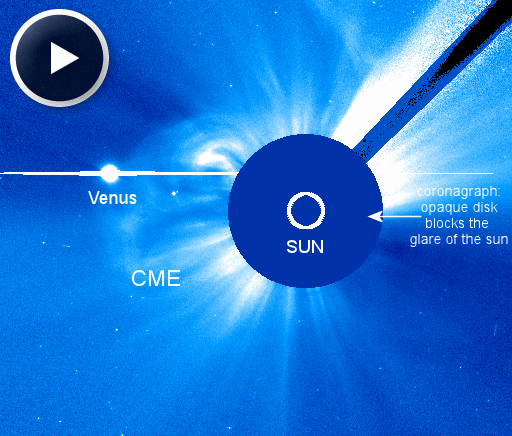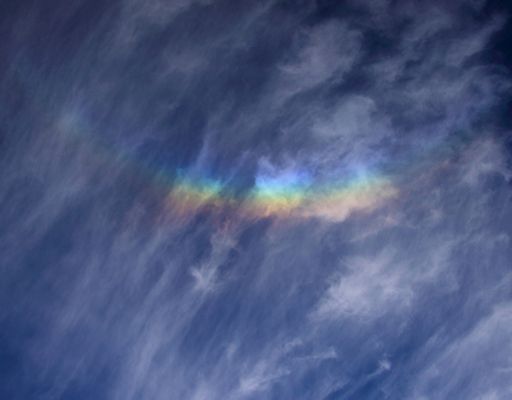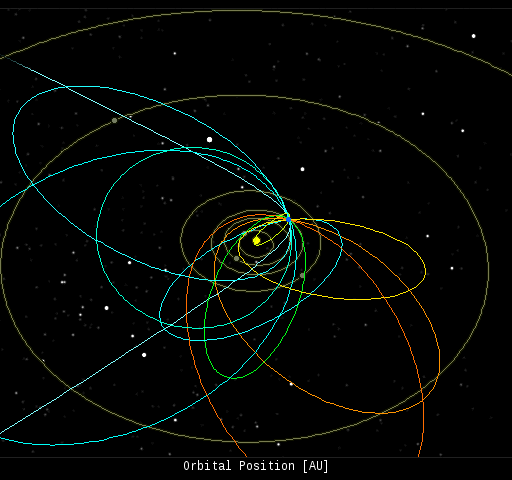Would you like a call when things are happening in the night sky? Sign up for backyard astronomy alerts from spaceweather.com: voice or text. | | | IMPROVING SERVICE: Spaceweather.com is migrating to a new high-performance server that can deliver space weather news during the high-traffic periods around intense solar storms. If you experience any hiccups while visiting the web site on Nov. 6-7, please let us know. SOLAR STORM CLOUDS MISS EARTH: Sunspot AR2205 is crackling with M-class solar flares. The blasts have hurled multiple CMEs into space, but so far none poses a threat to Earth. This movie from SOHO shows several storm clouds billowing over the sun's eastern limb on Nov. 5-6: 
Because AR2205 is not yet directly facing Earth, the CMEs are sailing wide of our planet. In the movie, Venus appears to be enveloped by the CMEs, but not really. The second planet from the sun is behind the clouds, not inside them. More eruptions are in the offing. AR2205 has an unstable 'beta-gamma-delta' magnetic field that harbors energy for strong flares and CMEs. NOAA forecasters estimate a 55% chance of M-flares and a 25% chance of X-flares during the next 24 hours. Realtime Space Weather Photo Gallery UPSIDE DOWN RAINBOWS: 'tis the season for upside-down rainbows. Just this week, one appeared over Sumirago (Varese), Italy: 
"Bright and multi-colored, it was visible from 10 a.m. until sunset," reports photographer Paolo Bardelli. The technical name for this phenomenon is circumzenithal arc or "CZA" for short--and it's no rainbow. CZAs are formed by sunlight shining through plate-shaped ice crystals in high clouds. Atmospheric optics expert Les Cowley calls it "the most beautiful of all ice haloes." First timers often describe the CZA as an 'upside down rainbow' and "someone has also likened it to 'a grin in the sky,'" he adds. Circumzenithal arcs typically appear in late autumn and early winter when the air is icy and the sun is low. "The CZA forms only when sun is less than 32.3° high," notes Cowley. As winter solstice approaches, "upside down rainbows" will become increasingly common. Look for them! Realtime Comet Photo Gallery
Realtime Aurora Photo Gallery
Realtime Eclipse Photo Gallery
Every night, a network of NASA all-sky cameras scans the skies above the United States for meteoritic fireballs. Automated software maintained by NASA's Meteoroid Environment Office calculates their orbits, velocity, penetration depth in Earth's atmosphere and many other characteristics. Daily results are presented here on Spaceweather.com. On Nov. 6, 2014, the network reported 11 fireballs.
(11 sporadics)  In this diagram of the inner solar system, all of the fireball orbits intersect at a single point--Earth. The orbits are color-coded by velocity, from slow (red) to fast (blue). [Larger image] [movies] Potentially Hazardous Asteroids ( PHAs) are space rocks larger than approximately 100m that can come closer to Earth than 0.05 AU. None of the known PHAs is on a collision course with our planet, although astronomers are finding new ones all the time. On November 6, 2014 there were 1511 potentially hazardous asteroids. Notes: LD means "Lunar Distance." 1 LD = 384,401 km, the distance between Earth and the Moon. 1 LD also equals 0.00256 AU. MAG is the visual magnitude of the asteroid on the date of closest approach. | | The official U.S. government space weather bureau | | | The first place to look for information about sundogs, pillars, rainbows and related phenomena. | | | Researchers call it a "Hubble for the sun." SDO is the most advanced solar observatory ever. | | | 3D views of the sun from NASA's Solar and Terrestrial Relations Observatory | | | Realtime and archival images of the Sun from SOHO. | | | from the NOAA Space Environment Center | | | the underlying science of space weather | | 
